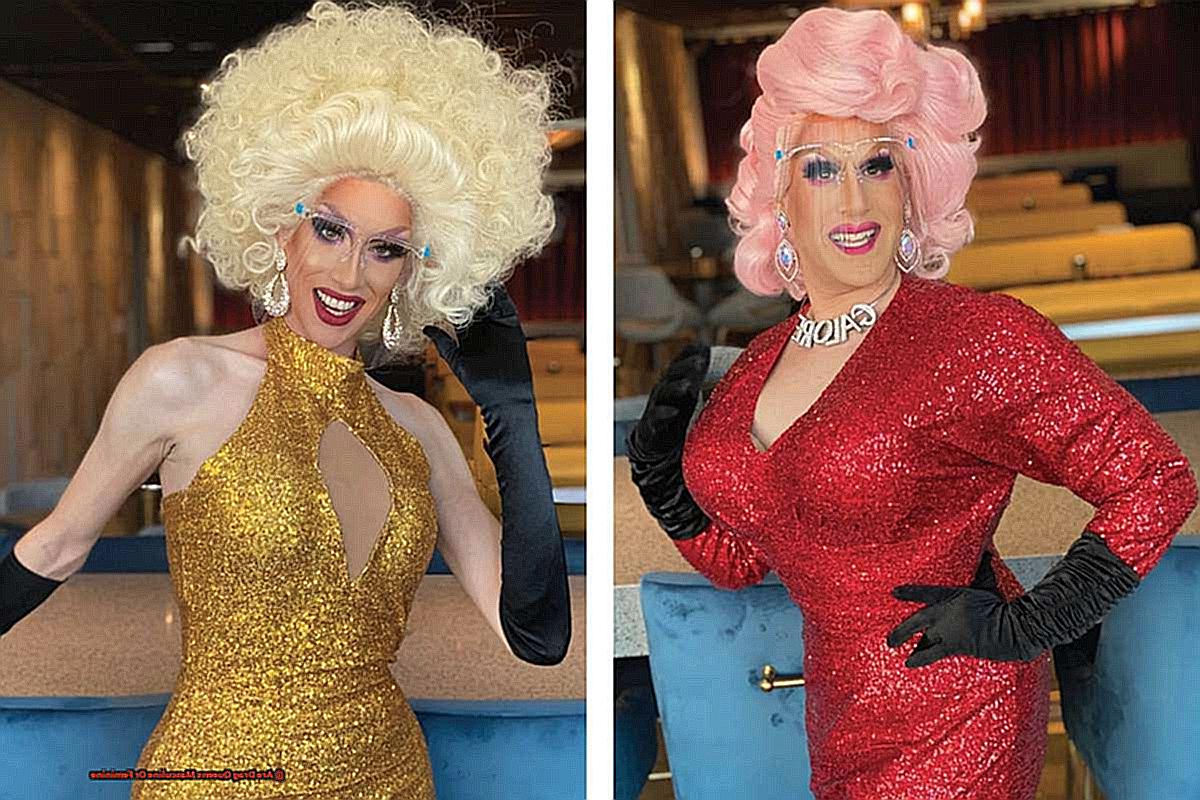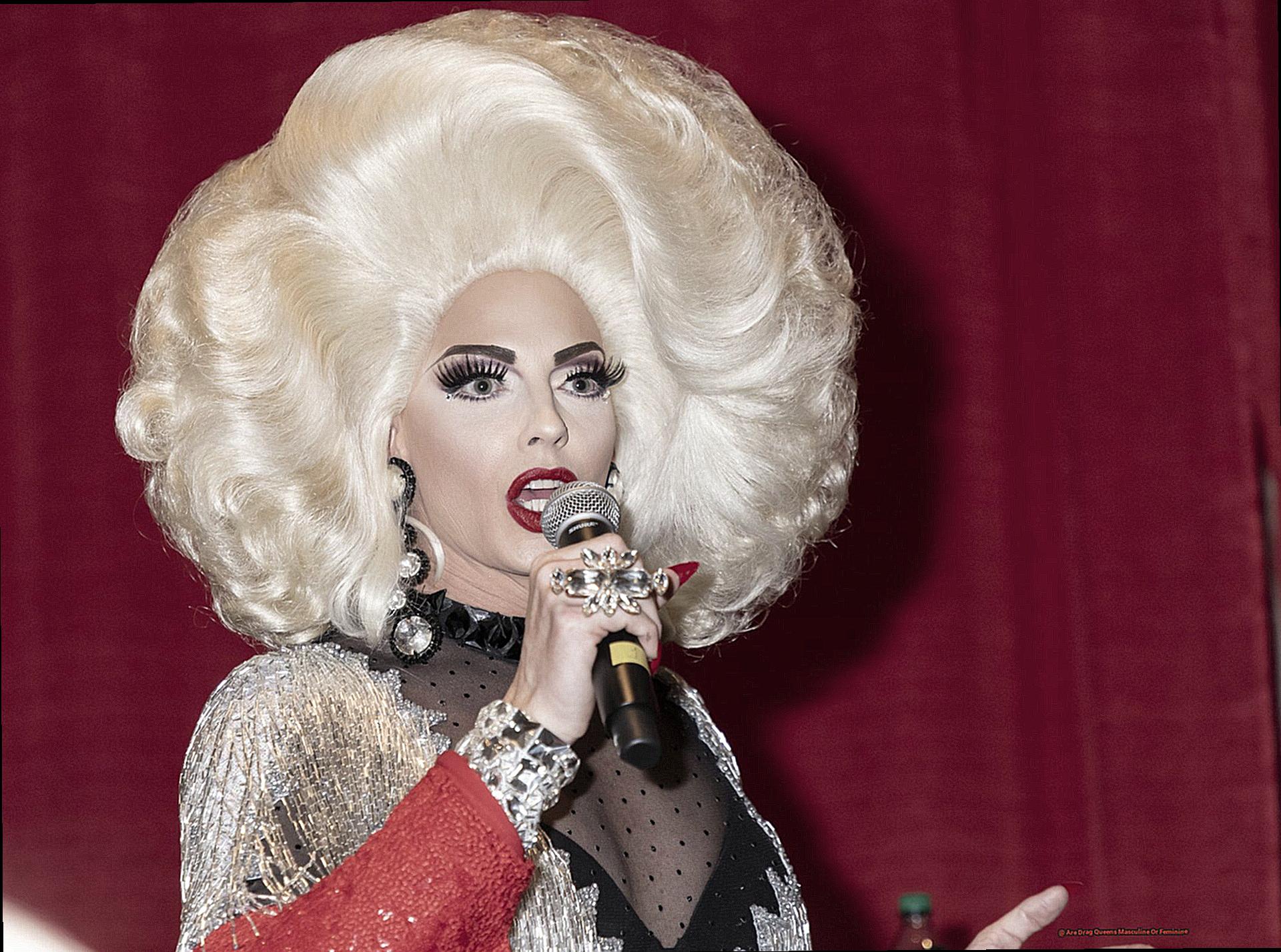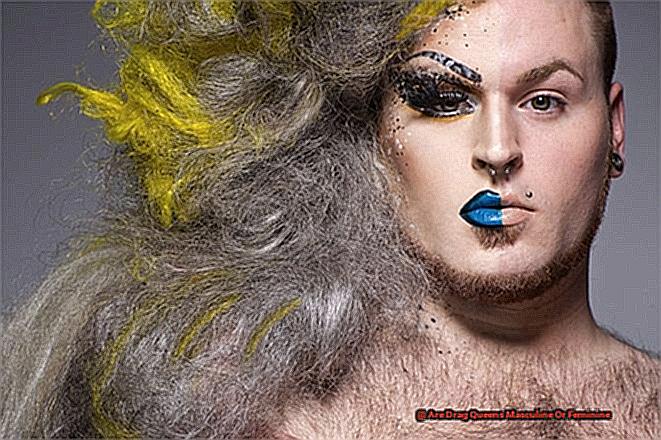
Ladies and gentlemen, welcome to the fabulous world of drag queens.
Contents
- 1 Are drag queens masculine or feminine
- 2 The Art of Drag: Skill, Creativity, and Dedication Required
- 3 Makeup, Wigs, and Costumes: Transforming into Exaggerated Femininity
- 4 Gender Fluidity and Breaking Societal Norms in Drag Performance
- 5 Identity and Expression: How Drag Queens Challenge Traditional Gender Roles
- 6 Masculine or Feminine? The Subjectivity of Gender Labels
- 7 Embracing Diversity and Fluidity in the World of Drag
- 8 Conclusion
These glamorous performers have been captivating audiences for decades with their larger-than-life personas and jaw-dropping performances. But behind the glitter and sequins lies a deeper question: are drag queens masculine or feminine?
It’s a complex topic that often sparks debate, but one thing is for sure – drag queens challenge societal norms and redefine what it means to be masculine or feminine. So let’s sashay into this blog post as we explore the history, style, and impact of drag queens on our perceptions of gender.
Get ready for a wild ride.
Are drag queens masculine or feminine
Drag queens have become a prominent part of the LGBTQ+ community, using their performances as a form of self-expression and entertainment. However, there is an ongoing debate about whether drag queens are masculine or feminine. As an expert on the topic, I will delve into this controversial topic and explore the evolving definitions of masculinity and femininity within the drag community.
The Concept of Masculinity and Femininity in Drag:
To understand the debate surrounding drag queens’ gender expression, we must first define what is considered masculine and feminine. Traditionally, masculinity was associated with strength, dominance, and aggression, while femininity was linked to traits like sensitivity, nurturing, and submissiveness. However, these narrow definitions are outdated and do not accurately represent the diverse spectrum of gender identities and expressions.
Drag queens challenge these rigid gender norms by embracing fluidity and blurring the lines between masculinity and femininity. They use their performances to express themselves in exaggerated forms of femininity, often using makeup, wigs, and elaborate costumes to transform their appearance. In doing so, they break traditional expectations of masculinity and challenge societal norms.
The Evolution of Drag:
The art of drag has a long history dating back to ancient times when men would dress in drag for theatrical performances. However, it wasn’t until the 20th century that drag as we know it today began to take shape. It became a form of entertainment in underground queer clubs and bars during the 1920s Prohibition era.
Today, drag has evolved into a subculture with its own set of rules, styles, and communities. It has become a platform for individuals to express their creativity and individuality through exaggerated gender performances. This evolution has also sparked discussions about the role of drag in promoting inclusivity and acceptance in society.
Famous Drag Queens and Their Unique Expressions:
There are countless famous drag queens who have made significant contributions to the art form. Each one has their own unique expression of gender identity, challenging traditional notions of masculinity and femininity. For example, RuPaul, the most well-known drag queen, presents a combination of masculinity and femininity in his performances. He often uses masculine elements like suits and heels to create a striking androgynous look.
The Art of Drag: Skill, Creativity, and Dedication Required
The art of drag has been around for centuries, with its roots in ancient Greek and Roman theater. However, it has evolved into a complex and highly skilled form of performance art that requires a combination of skill, creativity, and dedication.
Skill:
Drag queens are not just men dressing up as women; they are skilled performers who have a strong understanding of fashion, makeup techniques, and performance skills. Transforming into a drag queen is no easy feat – it takes years of practice to perfect the art. Drag queens must have a keen eye for fashion, knowing how to create unique and extravagant looks through the use of different fabrics, textures, and accessories.
They also need to be proficient in makeup application, using techniques such as contouring and highlighting to create an exaggerated and flawless appearance.
Creativity:
One of the most impressive aspects of drag is the level of creativity involved. Drag queens are not afraid to push boundaries and challenge societal norms through their performances. They use their art form to express themselves in exaggerated forms of femininity, showcasing their creativity and self-expression. Many drag queens also create their own costumes and makeup looks, using their talents to bring their visions to life.
Dedication:
The dedication required to perfect the art of drag is often overlooked. The process of getting into drag can take hours, with meticulous attention paid to every aspect of the look. From choosing the perfect outfit to applying flawless makeup and creating a unique character, drag queens put in a tremendous amount of effort and time into their performances. They also need to have a good grasp of music, choreography, and comedic timing to entertain their audiences.
Makeup, Wigs, and Costumes: Transforming into Exaggerated Femininity
Drag queens are known for their extravagant looks, larger-than-life personalities, and fearless attitudes. At the core of their performances lies the art of transforming into exaggerated femininity through the use of makeup, wigs, and costumes.
Let’s dive into how these elements are utilized by drag queens to challenge traditional gender norms and create a mesmerizing stage presence.
Makeup: The Power of Contouring and Highlighting
Makeup is an essential tool for drag queens, allowing them to transform their facial features to match their desired feminine look. Through contouring and highlighting techniques, they can create the illusion of a more feminine bone structure, accentuating their cheekbones, jawline, and nose. This mastery of makeup not only requires skill but also a deep understanding of facial anatomy.
Wigs: Long, Luscious Hair for Days
Long, flowing hair is often associated with femininity, and drag queens know how to work this to their advantage. Many queens opt for wigs that are styled in various ways, from sleek and straight to voluminous curls. These wigs not only add to the overall aesthetic but also allow them to play with different hairstyles and colors without damaging their natural hair.
Costumes: Glamour, Glitz, and Everything in Between
Drag queens are known for their extravagant costumes that leave audiences in awe. From bedazzled gowns to sequin jumpsuits, these outfits are carefully chosen to accentuate curves and showcase femininity. These costumes are not just pieces of clothing but works of art that require creativity, craftsmanship, and a whole lot of glitter.
The Art of Transformation: Breaking Free from Gender Norms
The transformation process for drag queens is not just about putting on makeup, wigs, and costumes – it is a form of artistry and expression. Through this process, they can break free from societal expectations and norms of gender and embrace their individuality. Drag queens use exaggerated femininity to celebrate and empower themselves, challenging the notion that femininity is only reserved for women.
Gender Fluidity and Breaking Societal Norms in Drag Performance

Drag performances have long been a staple in queer subcultures, captivating audiences with their vibrant and flamboyant displays of exaggerated femininity. But beyond the glitz and glamour lies a deeper message – the challenge to societal norms and promotion of gender fluidity.
So what is gender fluidity? It is the idea that gender is not a fixed concept but rather a spectrum that can be explored and expressed in various ways. And drag queens are masters at embodying this concept through their performances.
By blurring the lines between masculinity and femininity, drag queens break free from traditional gender norms and showcase the fluidity of gender. They challenge the societal notion that one must conform to a specific gender identity and expression, opening up possibilities for individuals to express themselves beyond traditional labels.
But it’s not just about breaking norms – drag performances also promote self-expression, inclusion, and acceptance. Many drag queens identify as gender-fluid or non-binary, further emphasizing the message that gender is not black and white, but rather a beautiful and diverse spectrum.
Through their extravagant performances, drag queens showcase that gender is a performance itself. They incorporate exaggerated expressions of femininity but also infuse elements of masculinity such as deep voices and physical strength. This fusion highlights the idea that gender can be altered or played with, challenging the binary understanding of gender.
As someone who has personally experienced the liberating feeling of embracing my true self through drag performance, I can attest to its power in promoting self-acceptance and celebrating individuality. And it’s not just for those within the queer community – anyone can enjoy and appreciate the artistry and message behind drag performances.
Identity and Expression: How Drag Queens Challenge Traditional Gender Roles
Drag queens have been a staple in the LGBTQ+ community for decades, known for their extravagant costumes, bold makeup, and larger-than-life performances. But beyond the glitz and glamour, drag is a form of art and self-expression that challenges traditional gender roles and societal expectations.
In this section, we will delve deeper into how drag queens use their performances to blur the lines between masculine and feminine, question societal norms surrounding gender and expression, and ultimately promote diversity and acceptance.

Breaking the Binary: Embracing Fluidity in Identity and Expression
One of the key ways in which drag queens challenge traditional gender roles is by embracing fluidity in both identity and expression. While many drag queens identify as male, some also identify as transgender or non-binary. This fluidity allows them to reject the notion that one must conform to strict gender binaries, instead embracing both masculine and feminine qualities.
This fluidity is also reflected in their performances, where they often blend elements of masculinity and femininity to create unique and captivating characters. By doing so, drag queens show that gender is not black and white, but rather a spectrum that can be explored and celebrated.
Subverting Expectations: Rethinking “Masculinity” and “Femininity”
Drag queens also challenge societal expectations of what it means to be “masculine” or “feminine.” Through their performances, they play with these labels, showing that they are subjective and can be manipulated. This subversion of traditional gender roles not only breaks down stereotypes but also invites individuals to question the rigidity of societal norms.
Representation for All: Fostering Inclusivity and Acceptance
In addition to challenging traditional gender roles, drag queens also provide representation for those who do not conform to these norms. By celebrating diversity in their performances, they create a sense of inclusivity within their communities. This is especially important for members of the LGBTQ+ community who may not see themselves represented in mainstream media.
Beyond Entertainment: Addressing Social and Political Issues
But drag performances are not just for entertainment. Many drag queens use their platform to address social and political issues such as LGBTQ+ rights, feminism, and body positivity. By incorporating these themes into their performances, they not only challenge societal norms but also promote important conversations and advocacy.
Masculine or Feminine? The Subjectivity of Gender Labels
When we hear the terms “masculine” and “feminine,” we often think of strict and binary categories that define certain traits and behaviors. However, these labels are not as fixed as we may think. In fact, they are highly subjective and can mean different things to different people. This is especially evident in the world of drag, where performers challenge traditional notions of masculinity and femininity.
Drag queens are known for their extravagant and exaggerated performances, often dressed in glamorous outfits and sporting bold makeup and hairstyles. They use their platform to entertain and push the boundaries of gender norms, blurring the lines between what is considered masculine or feminine.
But are drag queens more masculine or feminine? The truth is, it depends on who you ask. For some, the flamboyant appearance and exaggerated femininity of drag queens may seem more feminine. However, for others, their confidence, boldness, and ability to break societal norms may be perceived as more masculine.
It’s essential to understand that masculinity and femininity are social constructs that can mean different things to different people. Drag queens embody the fluidity of gender by challenging these limited notions and showing that it is not confined to strict labels.
While many drag queens identify as male or transgender, there are also those who embrace their identity as a drag queen without any specific gender label. This further emphasizes the subjectivity of gender labels and the importance of individual expression.
In their performances, drag queens often use exaggerated feminine characteristics as a form of expression and entertainment. However, this does not necessarily define their true identity or how they identify themselves outside of their performances.
The concept of being masculine or feminine is not black and white but rather a spectrum that is constantly evolving. Drag queens challenge traditional ideas of gender by embracing both aspects in their performances. This serves as a powerful reminder that gender expression should not be limited or defined by strict labels.
Embracing Diversity and Fluidity in the World of Drag
Drag has long been associated with spectacle and glamour, but it is also a world of acceptance and self-expression. It challenges traditional gender norms and celebrates diversity and fluidity, making it an important space for the LGBTQ+ community. As a specialist in this topic, I have explored the ways in which drag embraces diversity and fluidity, and I am excited to share my insights with you.
Blurring Gender Norms
One of the most striking aspects of drag is its ability to blur the lines between masculinity and femininity. Drag queens are larger-than-life characters who embrace both masculine and feminine elements in their performances. They challenge traditional gender labels and showcase the fluidity of gender expression, breaking free from societal expectations and definitions.
Embracing a Spectrum of Identities
Drag is not just about dressing up as the opposite gender; it is a form of self-expression and artistry. This is reflected in the diverse identities within the drag community. Some drag queens identify as men, while others identify as genderfluid or non-binary. This spectrum of identities is celebrated and embraced in the world of drag, promoting inclusivity and acceptance.
Using Their Platform for Good
Drag queens use their platform to bring attention to important social issues and promote acceptance and inclusivity. They are not just entertainers; they are activists who use their art to spread messages of love, equality, and empowerment. Through their performances, they challenge societal norms and inspire others to embrace their true selves.
A Diverse and Inclusive Community
The drag community itself is diverse and inclusive, welcoming people of all races, genders, sexual orientations, and body types. It is a space where everyone is accepted for who they are, without judgment or discrimination. This sense of community and belonging is what makes drag such a powerful force for change.
Breaking Barriers
In recent years, drag has gained more visibility through popular TV shows like RuPaul’s Drag Race and Pose. This mainstream exposure has allowed drag queens to become icons, challenging societal norms and breaking barriers. They have become role models for many, showing that there is no one way to express gender or identity.
Conclusion
In conclusion, the world of drag queens is a dazzling and fierce one, bursting with creativity, skill, and unwavering dedication. These performers challenge traditional gender norms and boldly redefine what it means to be masculine or feminine. Through their extravagant performances, they embrace fluidity and diversity, promoting acceptance and inclusivity in the LGBTQ+ community.
From their origins in ancient theater to their current status as powerful agents of change, drag queens have come a long way. They use their platform to break barriers and address social issues while also providing much-needed representation for those who do not conform to traditional gender labels.
However, despite the strides made in recent years towards greater acceptance and understanding of diverse expressions of gender, challenges still exist for drag queens in society. The ongoing debate about whether they are more masculine or feminine serves as a reminder that there is still work to be done in breaking down rigid gender stereotypes.
So let us continue to sashay forward into this fabulous world of drag queens with open minds and hearts, celebrating their artistry, individuality, and powerful message of inclusivity.


